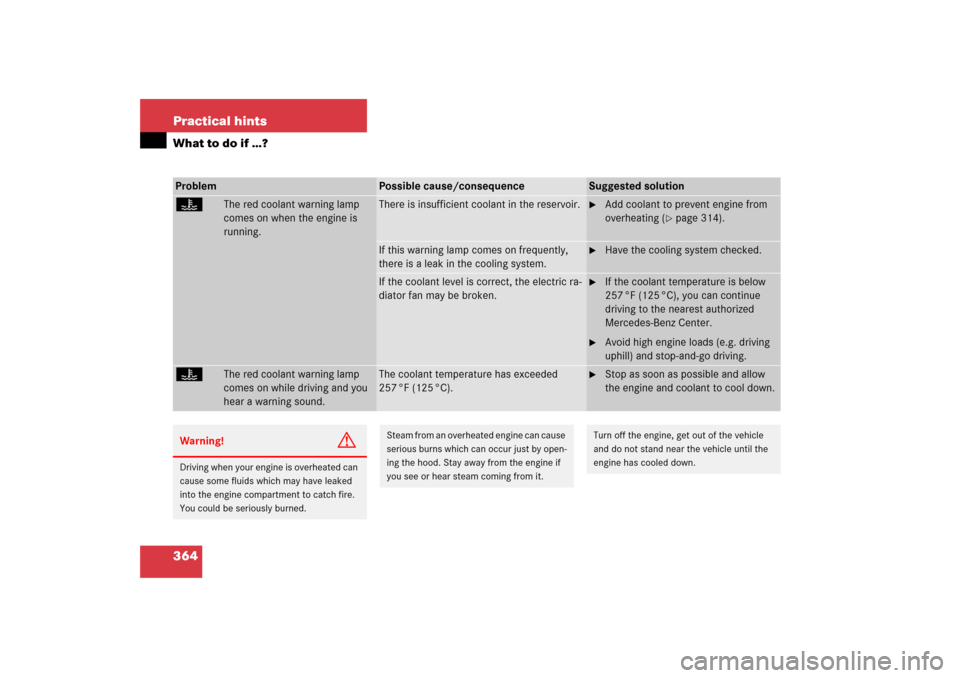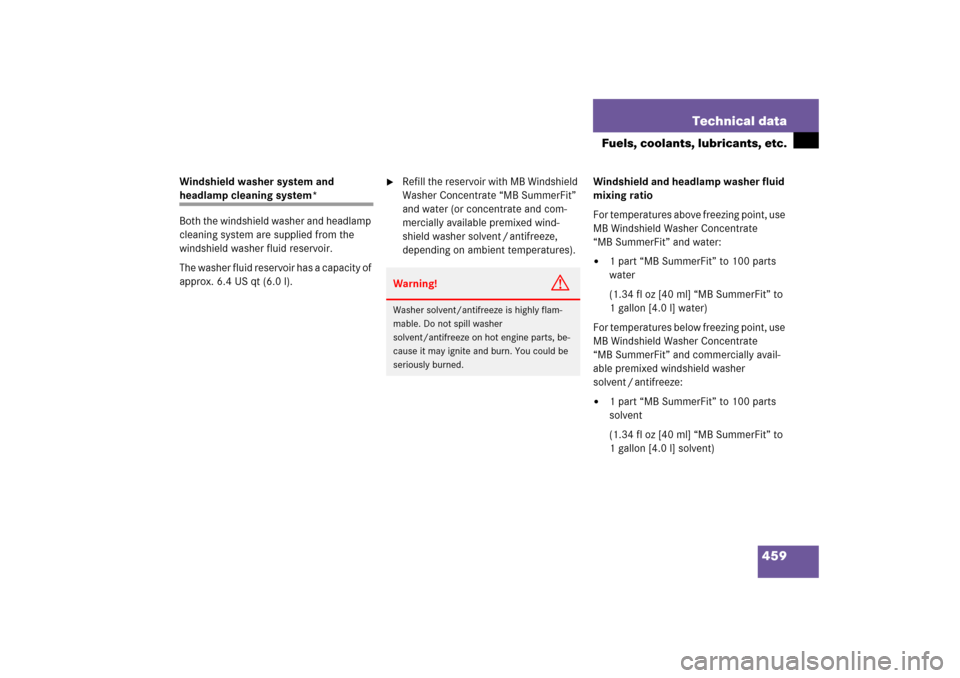Page 308 of 489

307 Operation
At the gas station
Check regularly and before a long tripEngine compartment (CLK 500, example)1Coolant level
2Brake fluid (fuse box cover removed)
3Windshield washer and headlamp
cleaning system*Coolant
For normal replenishing, use water (pota-
ble water quality). For more information,
see “Coolant” (
�page 314) and see “Fu-
els, coolants, lubricants, etc.”
(
�page 452).
Brake fluid
Removing fuse box cover,
see (�page 437).Windshield washer and headlamp
cleaning system*
For more information on filling up the
washer reservoir, see “Windshield washer
system and headlamp cleaning system*”
(
�page 316).
Engine oil level
For more information on engine oil, see
“Engine oil” (
�page 309).
Vehicle lighting
Check function and cleanliness. For more
information on replacing light bulbs, see
“Replacing bulbs” (
�page 412).
For more information, see “Exterior lamp
switch” (
�page 52).
Tire inflation pressure
For more information, see “Checking tire
inflation pressure” (
�page 328).
iOpening the hood, see (
�page 308).
!If you find that the brake fluid in the
brake fluid reservoir has fallen to the
minimum mark or below, have the
brake system checked for brake pad
thickness and leaks immediately.
Notify an authorized Mercedes-Benz
Center immediately. Do not add brake
fluid as this will not solve the problem.
For more information, see also “Practi-
cal hints” (
�page 361).
Page 315 of 489

314 OperationEngine compartmentCoolant
The engine coolant is a mixture of water
and anticorrosion/antifreeze. To check
the coolant level, the vehicle must be
parked on level ground and the engine
must be cool.
The coolant expansion tank is located on
the passenger side of the engine
compartment.
1Coolant expansion tank
2Cap
�
Using a rag, turn cap 2 slowly
approximately one half turn counter-
clockwise to release any excess pres-
sure.
�
Continue turning the cap 2 counter-
clockwise and remove it.
The coolant level is correct if the level
�
for cold coolant: reaches the marking
(plastic bridge) inside the reservoir
�
for warm coolant: is approx. 0.6 in
(1.5 cm) higher
�
Add coolant as required.
�
Replace and tighten cap 2.
More information on coolant can be found
in the “Technical data” section
(
�page 457).
Warning!
G
In order to avoid any possibly serious burns:�
Use extreme caution when opening the
hood if there are any signs of steam or
coolant leaking from the cooling system,
or if the coolant temperature indicator
indicates that the coolant is overheated.
�
Do not remove pressure cap on coolant
reservoir if the coolant temperature is
above 158°F (70°C). Allow the coolant
to cool down before removing cap. The
coolant reservoir contains hot fluid and
is under pressure.
�
Using a rag, slowly open the cap approx-
imately
1/2 turn to relieve excess pres-
sure. If opened immediately, scalding
hot fluid and steam will be blown out un-
der pressure.
�
Do not spill antifreeze on hot engine
parts. Antifreeze contains ethylene gly-
col which may burn if it comes into con-
tact with hot engine parts.
Page 365 of 489

364 Practical hintsWhat to do if …?Problem
Possible cause/consequence
Suggested solution
•
The red coolant warning lamp
comes on when the engine is
running.
There is insufficient coolant in the reservoir.
�
Add coolant to prevent engine from
overheating (
�page 314).
If this warning lamp comes on frequently,
there is a leak in the cooling system.
�
Have the cooling system checked.
If the coolant level is correct, the electric ra-
diator fan may be broken.
�
If the coolant temperature is below
257 °F (125 °C), you can continue
driving to the nearest authorized
Mercedes-Benz Center.
�
Avoid high engine loads (e.g. driving
uphill) and stop-and-go driving.
•
The red coolant warning lamp
comes on while driving and you
hear a warning sound.
The coolant temperature has exceeded
257 °F (125 °C).
�
Stop as soon as possible and allow
the engine and coolant to cool down.
Warning!
G
Driving when your engine is overheated can
cause some fluids which may have leaked
into the engine compartment to catch fire.
You could be seriously burned.
Steam from an overheated engine can cause
serious burns which can occur just by open-
ing the hood. Stay away from the engine if
you see or hear steam coming from it.
Turn off the engine, get out of the vehicle
and do not stand near the vehicle until the
engine has cooled down.
Page 460 of 489

459 Technical data
Fuels, coolants, lubricants, etc.
Windshield washer system and headlamp cleaning system*
Both the windshield washer and headlamp
cleaning system are supplied from the
windshield washer fluid reservoir.
The washer fluid reservoir has a capacity of
approx. 6.4 US qt (6.0 l).
�
Refill the reservoir with MB Windshield
Washer Concentrate “MB SummerFit”
and water (or concentrate and com-
mercially available premixed wind-
shield washer solvent / antifreeze,
depending on ambient temperatures).Windshield and headlamp washer fluid
mixing ratio
For temperatures above freezing point, use
MB Windshield Washer Concentrate
“MB SummerFit” and water:
�
1 part “MB SummerFit” to 100 parts
water
(1.34 fl oz [40 ml] “MB SummerFit” to
1 gallon [4.0 l] water)
For temperatures below freezing point, use
MB Windshield Washer Concentrate
“MB SummerFit” and commercially avail-
able premixed windshield washer
solvent / antifreeze:
�
1 part “MB SummerFit” to 100 parts
solvent
(1.34 fl oz [40 ml] “MB SummerFit” to
1 gallon [4.0 l] solvent)
Warning!
G
Washer solvent/antifreeze is highly flam-
mable. Do not spill washer
solvent/antifreeze on hot engine parts, be-
cause it may ignite and burn. You could be
seriously burned.